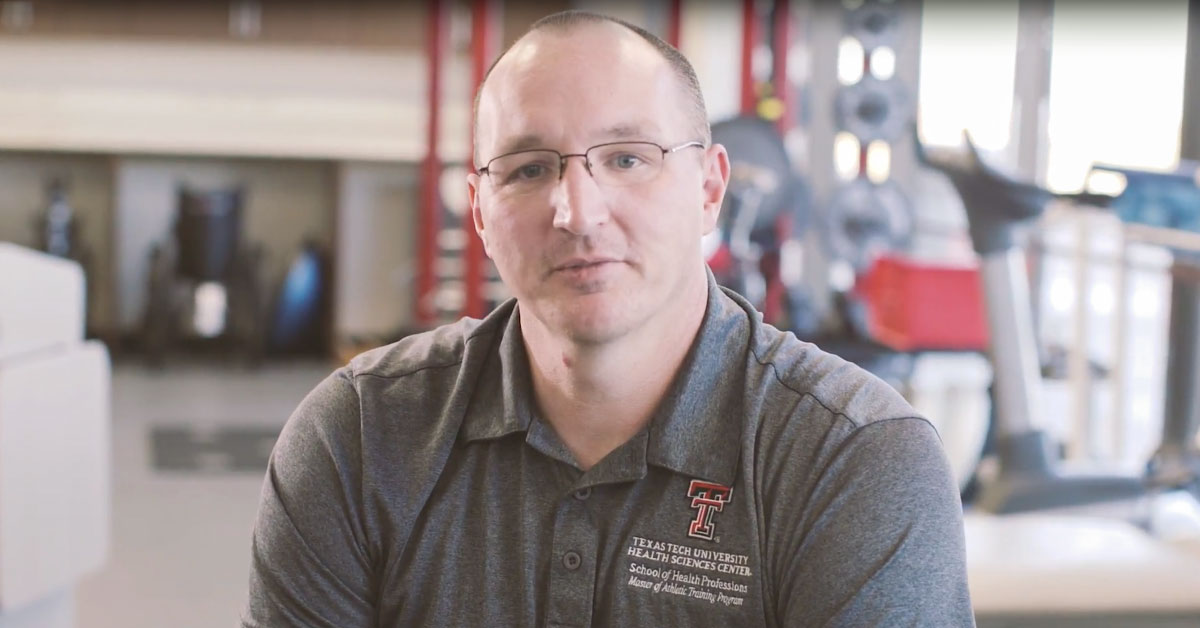TTUHSC’s Brooks Suggests Ways to Keep Mind and Body in Sync
Sometimes we don’t know how good we’ve got it until it goes away.
That can certainly apply to many people who are being forced to work from home due to the COVID-19 pandemic. With Zoom meetings, FaceTime and other technology, we may be able to maintain face-to-face contact, but we miss out on the simple take-it-for-granted physical exercise that comes from walking across campus or down long halls to speak to colleagues.

Toby Brooks, Ph.D.
It’s the same situation in which Toby Brooks, Ph.D., associate professor and program director of the master’s in athletic training program at the Texas Tech University Health Sciences Center, finds himself. When Brooks, who also serves as an adjunct professor for the Texas Tech University Department of Kinesiology, was transitioning his work setting from campus to his home, he moved his computer with him, but left behind his adjustable desk.
“I didn't want people to think I was looting my office by taking that with me, but man, I do miss that,” he said.
Without the adjustable desk, Brooks said he is more susceptible to sitting for prolonged periods of time, as are others who have moved from the office to the home. Prolonged sitting can lead to disuse of some muscles, which research has shown can start the atrophy process in as little as two weeks.
“We can lose efficiency in our neurologic system, and our neuromuscular connections can start to degrade,” Brooks explained. “A big concern for health care professionals during this time is if everyone in our country assumes a sedentary lifestyle all of a sudden, then health care costs down the road could be staggering.”
For example, when we take a road trip, we often sit for hours before fuel levels or Mother Nature forces us to make a stop. During that time some parts of our body, like the iliopsoas muscles the body uses to flex the thigh at the hip joint, can become sore. This soreness comes from our hips tightening, which often manifests in back pain. When we exit the car, we can stretch and exercise those muscles to reduce the tightness and get the blood flowing. Brooks said we should apply the same principle to working from home.
“Since I've adopted this new be-on-Zoom-all-day kind of setup, I will set an alarm or I'll intentionally get up and make sure that I stand for a couple of minutes, walk out in the yard, play with the dogs or whatever,” Brooks said. “Just don't be stuck in the chair for eight hours because that can lead to a number of bad things. And that's short term; if we're stuck in this holding pattern for weeks or months as I've heard, then again, that that can lead to a number of faulty postural patterns that are going to lead to long-term consequences.”
To reduce the chances of short- and long-term physical problems, Brooks suggested setting aside a minimum of 30 minutes each day to get away from the computer chair and do something physical. In addition to taking a walk, playing with the kids or running around with Rover, things like yard work, housework or sweeping out the garage can provide good physical stimulation. For those who may want a more structured workout regimen, apps like Fitbod and Shred can help replace the more formal training provided by now-closed gyms.
For those long periods of time when we are sitting in our makeshift home office, things like ankle pumps, toe taps or calf flexes can improve circulation between the heart and lower extremities. Brooks said even these simple movements help get the blood moving through veins that are buried within the muscles. That can be especially important for people with diabetes or other cardiovascular issues. He compares the benefits of these basic exercises to a tube of toothpaste; if the tube doesn’t get squeezed, the toothpaste has no reason to leave the tube.
“If I'm using the muscles in my calves, I am effectively encouraging that blood flow back to the heart,” Brooks explained. “So even something as simple as toe tappers or heel raises where I'm moving, that's better than nothing.”
If the new house-work dynamic includes an elderly parent or grandparent, it’s important to make sure they also have opportunities to get up and move. For seniors who may face an increased risk of falls, Brooks said there are chair aerobics programs available online. They can also do resistance work using exercise bands, and if exercise bands aren’t available, Brooks suggested sitting curls using soup cans, milk jugs or water bottles to provide the resistance.
“The biggest risk for the elderly is the fall risk, so we don't want to put any patient in a circumstance where they might potentially lose their balance and have a risk for injuries associated with that fall,” Brooks added. “Having them seated in a chair might be a viable alternative.”
So while working from home might tempt us to take our breaks on the couch rather than exercising, a number of studies have shown healthy minds and bodies work together to make a healthy person. When we’re in our usual daily routine balancing life at the office with family obligations, we often tell others, and ourselves, that we simply don’t have time to work out regularly. Brooks said we can’t allow that mindset to take over because present circumstances have moved us home to work.
“That's always been the excuse, right? ‘Oh, no, I don't have time to exercise.’ Well guess what, we are all magically thrown into this pot together. My hour-and-a-half that I usually spend on commuting, that's gone; I've got more time to exercise, so I would say start with 30 minutes and work up from there because I find that time spent in exercise means the time I spend in work is actually a lot more efficient and effective.”
